Museums have historically played a central role in shaping cultural narratives and preserving heritage. However, many of them are deeply rooted in colonial structures that have marginalized and silenced certain social groups. The decolonial museum establishes itself as a space that questions these practices and seeks to transform cultural institutions, making them more inclusive and representative.
What is a Decolonial Museum?
The decolonial museum aims to address and rectify the colonial legacies present in traditional museological practices. This involves deconstructing systems of prejudice, revaluing marginalized epistemologies and ontologies, and creating spaces that are respectful and inclusive. Restructuring these institutions requires the active involvement of the represented communities, fostering a horizontal dialogue in defining narratives and managing spaces.
Practical examples include initiatives such as the Marange Community Museum in Zimbabwe, where Indigenous epistemologies are at the core of museological practices. There, rituals and cultural objects are presented not as isolated artifacts but in meaningful dialogue with the local community.
The Role of the Curator in the Decolonial Museum
Traditionally seen as a guardian of knowledge, the curator in the decolonial museum takes on a more collaborative and reflective role. Instead of holding absolute authority over the documentation and interpretation of collections, they share these responsibilities with the represented groups.
One of the main changes in this role involves sharing responsibility for the collection with Indigenous communities and other historically marginalized groups. Facilitating collaborations also becomes essential, as dialogue between different groups shapes the exhibitions. Additionally, a critical review of collections is necessary, allowing the curator to analyze the works’ origins and question the colonial narratives embedded in the collection. In the aesthetic and epistemic realms, it becomes crucial to promote approaches that challenge paradigms imposed by the colonial museum tradition. Ethics plays a central role, in ensuring that issues such as cultural property, consent, and representation are handled with due care.
Moving away from a hierarchical model, the curator becomes a mediator, committed to making the museum a fairer and more equitable space, promoting the prominence of voices that have historically been silenced.
The Role of the Public in the Decolonial Museum
Public participation also undergoes a radical transformation in a decolonial museum. Visitors cease to be passive spectators and become active participants in the construction of knowledge.
Visitors contribute to the meaning of exhibitions based on their own experiences and perspectives. In many cases, interactivity is encouraged, allowing the handling of some objects to provide a more direct connection with the collection. Collaboration between the museum and the community strengthens, as local members themselves can participate in the development and assembly of exhibitions. Decision-making about the museum space becomes shared, ensuring broader involvement in defining institutional policies.
Beyond these transformations, critical reflection becomes a central element, encouraging visitors to question representations and narratives displayed to understand the underlying historical and cultural processes. Each individual interprets exhibitions according to their personal repertoire, making the experience unique and subjective.
The decentralization of authority in the decolonial museum creates a space of resistance, where memory and history are collectively rethought, and articulated with social movements and marginalized groups. This new model challenges the public to take on a more active role, creating experiences that break with the traditional hierarchical relationship between the museum and its visitors.
Conclusion
The decolonial museum proposes a structural and epistemological shift in how museums operate, interpret, and share knowledge. The curator ceases to be a centralizing figure and takes on the role of mediator and facilitator of dialogue between different agents. The public, in turn, gains prominence in constructing narratives and the museum experience. This approach represents a fundamental step for museums to become more democratic, inclusive, and connected to contemporary social dynamics.

